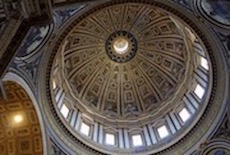
The story of St. Peters Basilica begins with the crucifixion of Peter, one of the apostles of Jesus, in 64 AD. He was crucified upside down on a cross in Circus of Nero, and buried nearby on what is now the Vatican Hill. Emperor Constantine The Great built the Old Basilica between 319 AD and 333 AD on the grounds of the burial spot of St. Peter. Later on, in the 16th Century at the behest of Pope Julius II, the current St. Peters Basilica was built.St. Peters Basilica is currently a Papal Basilica and is famous for being the site of St. Peters Tomb and the Chair of St. Peter, which confers a spiritual authority to the Pope. However, it is not the official Basilica of the Pope, but all major Papal functions and events are conducted here due to its sheer size and importance. St. Peters Basilica holds a lot of records including the largest church building in the world, second tallest building in Rome and the tallest dome in the world. Apart from that it is also conferred as a UNESCO World Heritage Site for the wealth of art and culture it embodies and preserves.
The construction of St. Peters Basilica took over a century in the making! The planning of the Basilica started when Pope Julius II commissioned a competition to design the grandest building in Christendom. The winner of the competition was Donato Bramante, and the foundation stone was laid in 1506. A series of deaths and personnel changes led to the change of architects from Bramante to Raphael to eventually Michelangelo in 1547. The final dome and the architecture are accredited to the brilliance of Michelangelo who based it on the designs of Bramante. The Basilica is built in the traditional Renaissance architecture and has been an inspiration for church buildings across the world. The iconic facade was designed by Maderno and remains an unforgettable memory in millions of pilgrims who visit it each year to see the Pope.
The Dome or the Cupola of the St. Peters Basilica is one of the largest domes in the world. The design of the Dome is attributed to Michelangelo; however the construction of the dome was completed only in 1590, by his pupil Giacomo Della Porta. The cupola has several elements across six concentric circles, including 16 large windows, busts, frescos and figurines of over 96 figures. You can climb 231 steps or take the elevator to reach the base and climb up another 320 steps to reach the top of the cupola for unhindered views of the Vatican and Rome.
The Pieta is one of the most recognisable statues in the world and was created by the Italian Master Michelangelo. The Carrara marble structure depicts Jesus after his crucifixion in the lap of Mother Mary. Almost 6 feet in height, the sculpture towers and exudes a monumental aura that portrays the sanctity of the moment. Pieta roughly translates to Pity in English, is the only sculpture that was signed by Michelangelo and was created in the late 15th century. You can find this breathtaking statue in the first chapel on the right as soon as you enter St. Peters Basilica.
Baldachin, otherwise known as ciborium, means a canopy or a structure that is placed over an altar. In St. Peters Basilica, the baldachin over the high altar rises magnificently becoming the focal point of the hall. It is placed directly above St. Peters Tomb and under the dome, and it is where the Pope celebrates Mass. The bronze structure was the first work created in Bernini in the Basilica and took nine years to complete and was finished in 1634. It is designed in classic Baroque style and became a standard for church interiors and architecture.
Home page